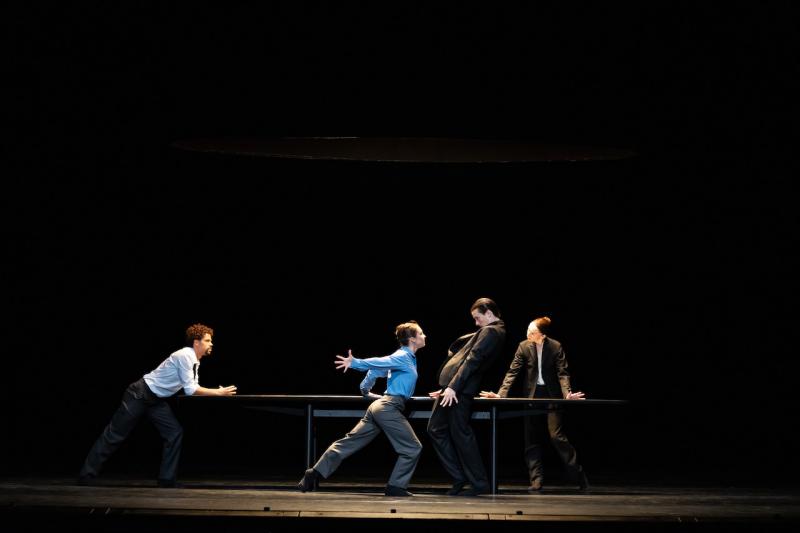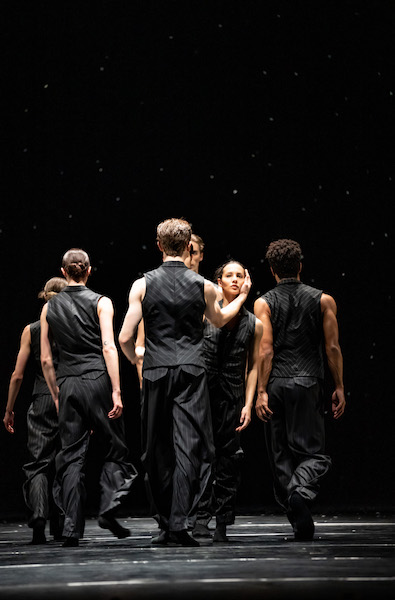The Royal Ballet: 21st-Century Choreographers review - dancers rise to fresh challenges | reviews, news & interviews
The Royal Ballet: 21st-Century Choreographers review - dancers rise to fresh challenges
The Royal Ballet: 21st-Century Choreographers review - dancers rise to fresh challenges
As Covent Garden opens up, the ballet company sets its face in a new direction

The Royal Opera House wasn't taking any chances when it welcomed its first ballet audience since December this week. There was no printed programme on offer, nor even a cast sheet. “Not till October” said the uniformed man on the door. Some ballet companies have learnt the hard way not to trust that newly lifted lockdowns (lockups?) will stay that way for long.
The programming felt confident though. The soft option for the Royal Ballet’s comeback would have been a comforting classic, but instead there’s a sense of starting afresh with work by three current, young-ish choreographers, one of them new to this company. Pittsburgh-born Kyle Abraham is already making waves in America bringing a streetdance buzz to ballet. The Royal has commissioned him to make a substantial work next season, so at just 10 minutes this new piece is something of a taster. Optional Family: A Divertissement is a trio whose tone of wry dysfunctionality is set by a synthesised voiceover. These are the unspoken thoughts of a longterm couple in crisis. “You bore me,” “Oh how I long for the longest distance from you.” “All you’ve given me is three ungrateful children”… But this is no kitchen-sink drama. The curtain rises on Natalia Osipova, crop-haired and muscular in a peach, ostrich-feathered minidress, bouréeing in wide, fussing loops around Marcelino Sambé, whose angry athleticism on the empty black stage seems wound taut by the grumbling electronic score. Which of them (pictured above) has the upper hand? You’re just starting to think you've read the situation when a third element, dancer Stanisław Węgrzyn, powers into the mix. Are the two men rivals, or are they conspiring together against Osipova? Both, possibly, and yet Osipova hardly looks a victim. The riddle is left unsolved.
Optional Family: A Divertissement is a trio whose tone of wry dysfunctionality is set by a synthesised voiceover. These are the unspoken thoughts of a longterm couple in crisis. “You bore me,” “Oh how I long for the longest distance from you.” “All you’ve given me is three ungrateful children”… But this is no kitchen-sink drama. The curtain rises on Natalia Osipova, crop-haired and muscular in a peach, ostrich-feathered minidress, bouréeing in wide, fussing loops around Marcelino Sambé, whose angry athleticism on the empty black stage seems wound taut by the grumbling electronic score. Which of them (pictured above) has the upper hand? You’re just starting to think you've read the situation when a third element, dancer Stanisław Węgrzyn, powers into the mix. Are the two men rivals, or are they conspiring together against Osipova? Both, possibly, and yet Osipova hardly looks a victim. The riddle is left unsolved.
Text plays a more integral part in The Statement (pictured top), a work made by Crystal Pite for Nederlands Dance Theatre but hungrily taken up by the Royal Ballet on the strength of their work with her on the migration ballet Flight Pattern, the hit of 2017. The Statement was originally a four-handed one-act play by Jonathon Young, and its recorded dialogue remains in Pite’s dance translation. The action happens around a large black table – perhaps in a company boardroom. Around it and sometimes on it, two men and two women, dressed for business, discuss the terms of an official statement whose exact nature we never learn. There is “a situation that needs to be cleared up”, and the protagonists seem to believe they are being scapegoated. “We should tell the truth,” one insists.”That’s impossible,” says another. “We have to stay on script”. The lack of any pinpointable meaning in these urgent negotiations, the verbal swerves and obfuscations, is both sinister and very funny. As, too, is the negotiators’ body language, a cartoonish exaggeration of normal office behaviours, delivered at whip-smart speed. Hands splay wide on the table, heads butt combatively. When doubts are voiced, legs get the jitters. It’s a brilliant conceit, and these dancers rise magnificently to the challenge.
 Solo Echo (pictured right) uses more dancers, and at first seems more conventional in setting extracts from two Brahms cello sonatas. But here too Pite plays on the ability of dance to deliver meaning incrementally. As snow drifts down prettily in the background, the dancers are buffeted by the music’s high romance through a series of rumbustious solos and duets. Later the mood becomes fraught as motifs of support and falling accumulate. If Pite has a choreographic signature, it’s her use of queues or piles of bodies. She’s great at manipulating numbers into poetic ideas. Here, when dancers peel away from group it’s like a series of absences among old friends. It’s only in the final moments that you clock Pite’s theme: a completed cycle of life and love.
Solo Echo (pictured right) uses more dancers, and at first seems more conventional in setting extracts from two Brahms cello sonatas. But here too Pite plays on the ability of dance to deliver meaning incrementally. As snow drifts down prettily in the background, the dancers are buffeted by the music’s high romance through a series of rumbustious solos and duets. Later the mood becomes fraught as motifs of support and falling accumulate. If Pite has a choreographic signature, it’s her use of queues or piles of bodies. She’s great at manipulating numbers into poetic ideas. Here, when dancers peel away from group it’s like a series of absences among old friends. It’s only in the final moments that you clock Pite’s theme: a completed cycle of life and love.
Christopher Wheeldon’s The Golden Hour, at the top of the bill, uses large forces and provides the relief from all that black. Vivaldi’s “Summer” meets Cajun folk in Ezio Bosso’s gorgeous music for strings, while Jasper Conran’s costumes shimmer and wink under gilded light. This piece has earned its keep for the Royal Ballet over the past year, not least as the headline item in its winter streaming while Britain was at its gloomiest. Happily, it’s a piece that bears much repeating.
rating
Explore topics
Share this article
The future of Arts Journalism
You can stop theartsdesk.com closing!
We urgently need financing to survive. Our fundraising drive has thus far raised £49,000 but we need to reach £100,000 or we will be forced to close. Please contribute here: https://gofund.me/c3f6033d
And if you can forward this information to anyone who might assist, we’d be grateful.

Subscribe to theartsdesk.com
Thank you for continuing to read our work on theartsdesk.com. For unlimited access to every article in its entirety, including our archive of more than 15,000 pieces, we're asking for £5 per month or £40 per year. We feel it's a very good deal, and hope you do too.
To take a subscription now simply click here.
And if you're looking for that extra gift for a friend or family member, why not treat them to a theartsdesk.com gift subscription?
more Dance
 'We are bowled over!' Thank you for your messages of love and support
Much-appreciated words of commendation from readers and the cultural community
'We are bowled over!' Thank you for your messages of love and support
Much-appreciated words of commendation from readers and the cultural community
 R:Evolution, English National Ballet, Sadler's Wells review - a vibrant survey of ballet in four acts
ENB set the bar high with this mixed bill, but they meet its challenges thrillingly
R:Evolution, English National Ballet, Sadler's Wells review - a vibrant survey of ballet in four acts
ENB set the bar high with this mixed bill, but they meet its challenges thrillingly
 Like Water for Chocolate, Royal Ballet review - splendid dancing and sets, but there's too much plot
Christopher Wheeldon's version looks great but is too muddling to connect with fully
Like Water for Chocolate, Royal Ballet review - splendid dancing and sets, but there's too much plot
Christopher Wheeldon's version looks great but is too muddling to connect with fully
 iD-Reloaded, Cirque Éloize, Marlowe Theatre, Canterbury review - attitude, energy and invention
A riotous blend of urban dance music, hip hop and contemporary circus
iD-Reloaded, Cirque Éloize, Marlowe Theatre, Canterbury review - attitude, energy and invention
A riotous blend of urban dance music, hip hop and contemporary circus
 How to be a Dancer in 72,000 Easy Lessons, Teaċ Daṁsa review - a riveting account of a life in dance
Michael Keegan-Dolan's unique hybrid of physical theatre and comic monologue
How to be a Dancer in 72,000 Easy Lessons, Teaċ Daṁsa review - a riveting account of a life in dance
Michael Keegan-Dolan's unique hybrid of physical theatre and comic monologue
 A Single Man, Linbury Theatre review - an anatomy of melancholy, with breaks in the clouds
Ed Watson and Jonathan Goddard are extraordinary in Jonathan Watkins' dance theatre adaptation of Isherwood's novel
A Single Man, Linbury Theatre review - an anatomy of melancholy, with breaks in the clouds
Ed Watson and Jonathan Goddard are extraordinary in Jonathan Watkins' dance theatre adaptation of Isherwood's novel
 Peaky Blinders: The Redemption of Thomas Shelby, Rambert, Sadler's Wells review - exciting dancing, if you can see it
Six TV series reduced to 100 minutes' dance time doesn't quite compute
Peaky Blinders: The Redemption of Thomas Shelby, Rambert, Sadler's Wells review - exciting dancing, if you can see it
Six TV series reduced to 100 minutes' dance time doesn't quite compute
 Giselle, National Ballet of Japan review - return of a classic, refreshed and impeccably danced
First visit by Miyako Yoshida's company leaves you wanting more
Giselle, National Ballet of Japan review - return of a classic, refreshed and impeccably danced
First visit by Miyako Yoshida's company leaves you wanting more
 Quadrophenia, Sadler's Wells review - missed opportunity to give new stage life to a Who classic
The brilliant cast need a tighter score and a stronger narrative
Quadrophenia, Sadler's Wells review - missed opportunity to give new stage life to a Who classic
The brilliant cast need a tighter score and a stronger narrative
 The Midnight Bell, Sadler's Wells review - a first reprise for one of Matthew Bourne's most compelling shows to date
The after-hours lives of the sad and lonely are drawn with compassion, originality and skill
The Midnight Bell, Sadler's Wells review - a first reprise for one of Matthew Bourne's most compelling shows to date
The after-hours lives of the sad and lonely are drawn with compassion, originality and skill
 Ballet to Broadway: Wheeldon Works, Royal Ballet review - the impressive range and reach of Christopher Wheeldon's craft
The title says it: as dancemaker, as creative magnet, the man clearly works his socks off
Ballet to Broadway: Wheeldon Works, Royal Ballet review - the impressive range and reach of Christopher Wheeldon's craft
The title says it: as dancemaker, as creative magnet, the man clearly works his socks off
 The Forsythe Programme, English National Ballet review - brains, beauty and bravura
Once again the veteran choreographer and maverick William Forsythe raises ENB's game
The Forsythe Programme, English National Ballet review - brains, beauty and bravura
Once again the veteran choreographer and maverick William Forsythe raises ENB's game

Add comment